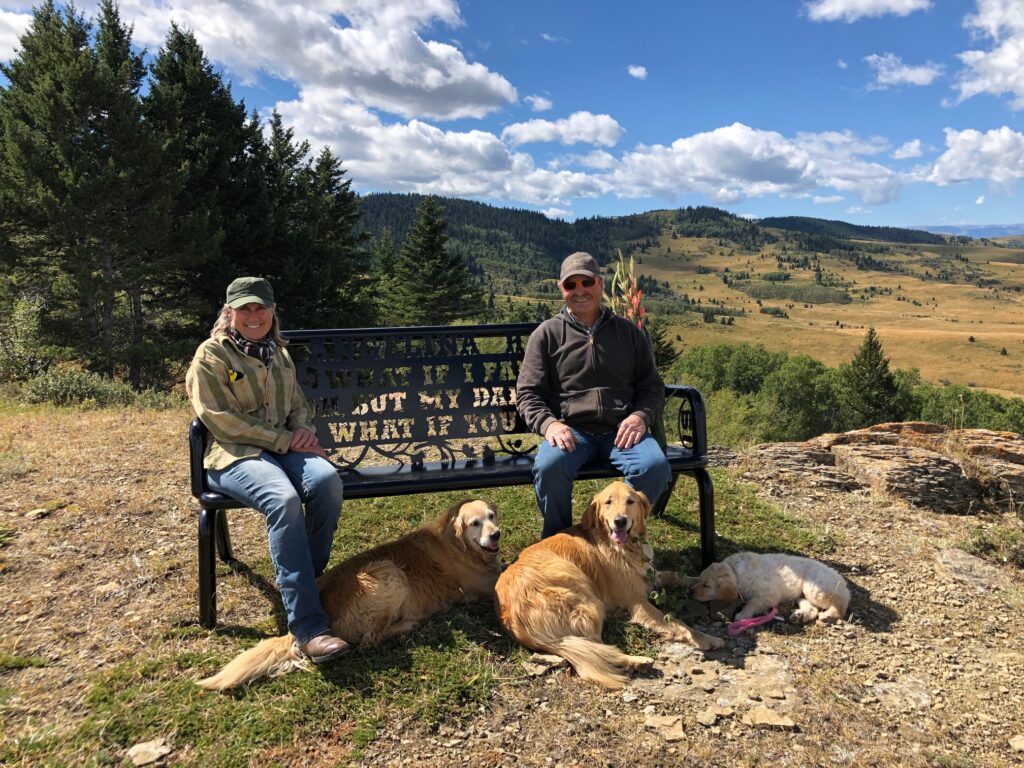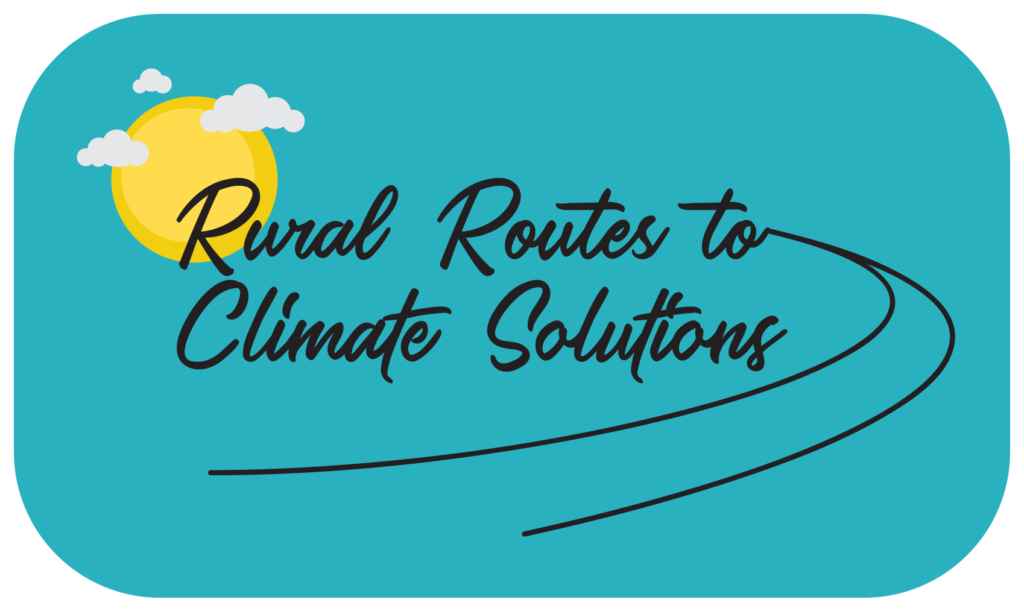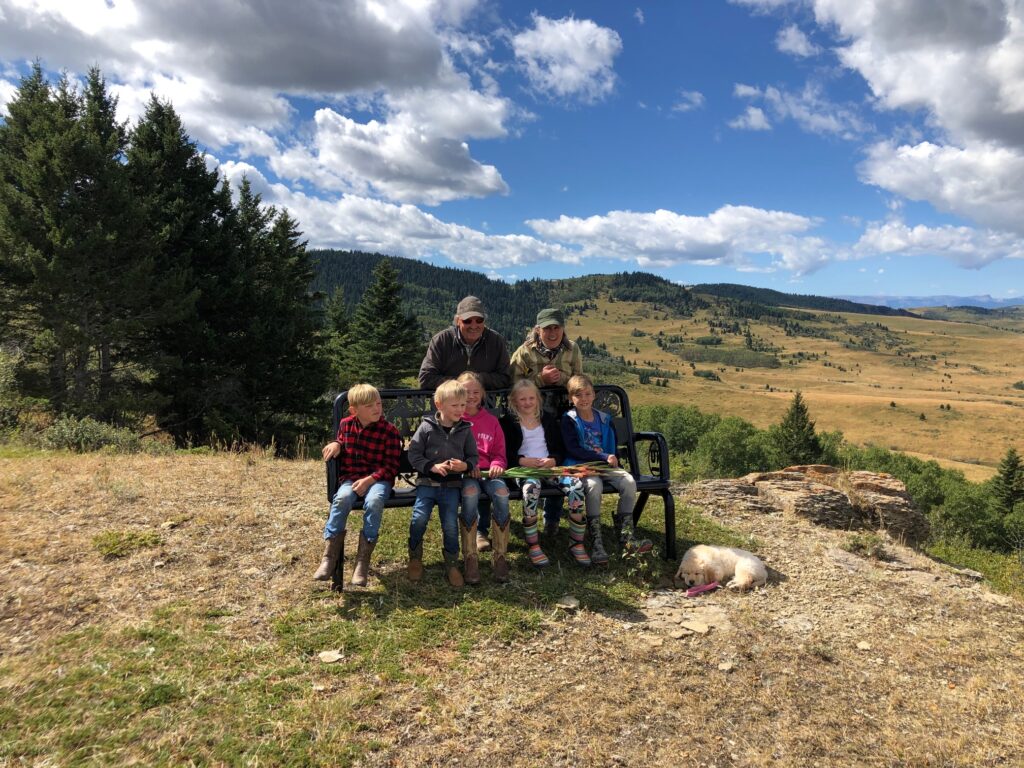 By Trina Moyles
By Trina MoylesGlen and Kelly Hall have been managing Timber Ridge Ranch, a 480-acre farmland situated an hour south of Calgary near Stavely, Alberta, for over 40 years. Their approach to agriculture involves regenerative practices and the conversion of their land back to perennial coverage, including the cultivation of multi or polyculture crops for swath grazing. Their operations primarily consist of a cow-calf program with approximately 200 mother cows, and they also custom graze calves from fall to spring.
Since 2018, the Halls have been on a mission to collaborate with local organizations to rejuvenate their land, which was previously subjected to conventional farming methods involving fertilizers, herbicides, and pesticides. Over the last four decades, they have seeded an impressive 5,000 acres, aiming to enhance biodiversity both above and below the soil.
We spoke to the Halls about the challenges of ranching in Alberta’s drought-prone “banana belt” and how they’re adapting their practices to “drought proof” against increasingly warming temperatures and extreme conditions.
What does regenerative agriculture mean to you at Timber Ridge?
Kelly: I think something that’s really important to recognize is that we live in what everybody around here calls the banana belt. In southern Alberta, drought is a good friend of ours. We always say we’re either in a drought, or planning for the next one, or recovering from the last one. The regenerative agriculture focus for us is capturing every single drop of rain.
In the early 80s, we had a real dry spell. And then in 1985, when we bought the ranch, we were very excited to be able to purchase a piece of property that’s in the headwaters of Nanton Creek and Oxley Creek. It became one of our main focuses to look after that watershed, which means also making sure that we leave the grass in a way that looks after the soil again.
Our land at the ranch makes things interesting because we have lots of aspen and conifer forest, and high topography. We practice what we call a managed grazing system. We can actually split several of our quarters in half, and our cows are usually moved every two to three weeks, depending on the precipitation that we’ve had and the cover that we’ve left behind. Every piece of the field that they’ve grazed then gets left for the rest of the year, and has a long rest period. We leave a cover over the soil that acts like what we call a sunscreen, which stops erosion and slows down evaporation.
That’s the first time I’ve heard anyone refer to cover as “sunscreen for the soil” — that’s a really cool way to educate people on the importance of covering the soil.
Kelly: Well, the sun has amazing power, and if we can keep those roots cooler, it makes sense, right?
Absolutely. Can you talk more about your approach of multi-species cropping and swath grazing?
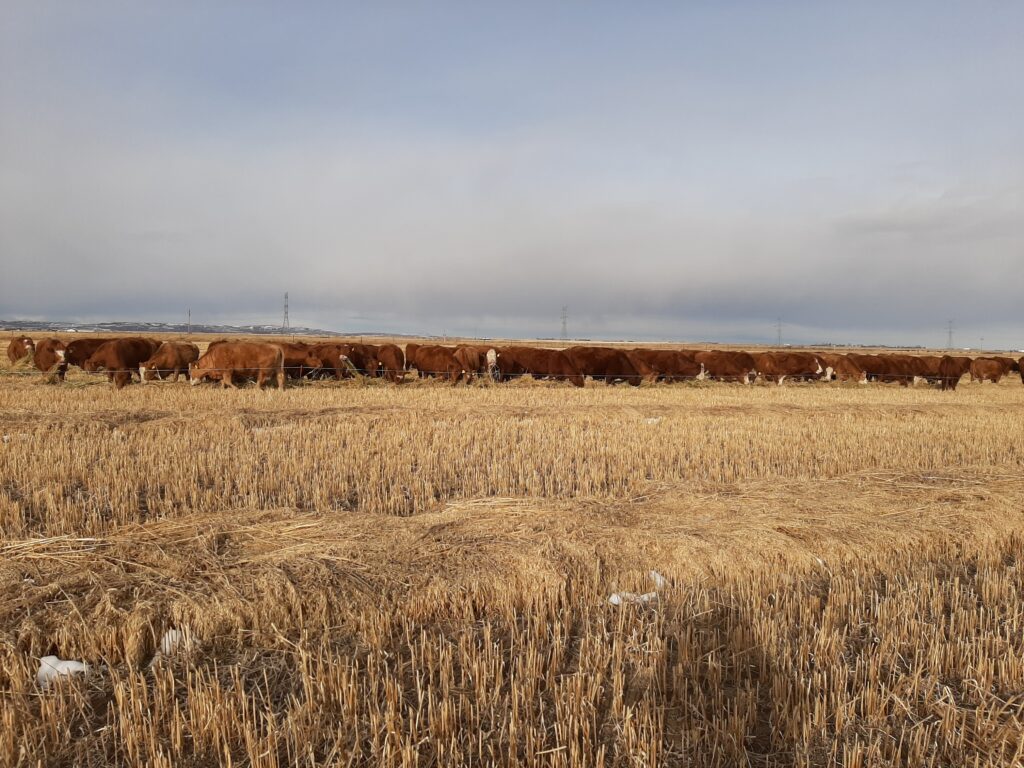 Glen: For the last seven or eight years we’ve been seeding brassicas with oats and forage peas. So brassicas are in the kale family — kale, cabbage, turnip family. It’s good quality feed, high in protein and fibers for the cattle, but also, the root systems help to break up the hard pan soil that’s formed from being conventionally farmed for years. It gets hardpan, so then the water cannot get down deep enough. So these types of crops, like the turnip crop, will break that hardpan up naturally. The foraging peas are a nitrogen fixer in the soil, and the oats have lots of sugars for feeding the soil biology for ensuring healthy biodiversity of the soil.
Glen: For the last seven or eight years we’ve been seeding brassicas with oats and forage peas. So brassicas are in the kale family — kale, cabbage, turnip family. It’s good quality feed, high in protein and fibers for the cattle, but also, the root systems help to break up the hard pan soil that’s formed from being conventionally farmed for years. It gets hardpan, so then the water cannot get down deep enough. So these types of crops, like the turnip crop, will break that hardpan up naturally. The foraging peas are a nitrogen fixer in the soil, and the oats have lots of sugars for feeding the soil biology for ensuring healthy biodiversity of the soil.
Kelly: The other advantage with the brassicas is that they can be pretty tough. For example, a turnip crop can tolerate an early frost in September and they’ll continue to grow and stay green longer. They don’t ripen as fast as some of the other cereal crops would. It’s kinda cool to watch the cattle eat turnips because they’ll eat the leaf first, then the stem, then they’ll pull the turnip up and eat that, as well. The duration of the green is important to us in the sense that the longer we can keep things green the more the transfer of nutrients is occurring in the soil biology.
Our cover crop cocktail has resulted in an immense reduction in synthetic fertilizers, herbicides, and pesticides. We do a single burn-off before we seed, just to try to reduce weeds, but then after, we only apply the fertilizer that is required after our soil tests come back. We understand that you can’t just go cold turkey, we do recognize that the plants are going to need something. So we rely on soil tests every spring to apply only what’s required.
We swath our crops and then swath graze during the winter. Our custom cattle and mother cows, before calving, they’ll go out onto swath grazing. Depending on the number of cattle in the field and their nutrition requirements, we calculate this and move the fences every day.
How is swath grazing beneficial for soil health?
Kelly: We seed in late June, then we hope to cut the crop in September.
Instead of using inputs and baling, we actually leave the crop laying on the ground with the hope that, with the correct temperatures and amount of moisture, that it actually stays somewhat green — and then we swathe it. It can lay there all winter and hold its nutritional value. We measure how much we need for the herd that’s there. Cows have four legs — so we let the cows do the walking instead of us doing the blazing. The beauty of it is that they’re feeding themselves. We use less fuel and leave behind less of an environmental footprint. And most importantly, the cows leave behind manure and help us fertilize the land.
Glen: It’s sort of mimicking when the buffalo roamed the land. They’re only there for like 24 hours and then they’re moved. We’re talking five, six hundred head of yearlings, so there’s lots of cattle within half a mile long with a swath that’s 30 feet wide. It’s lined with cattle from one end to the other.
Can you share more about your irrigation systems for watering cattle through the winter?
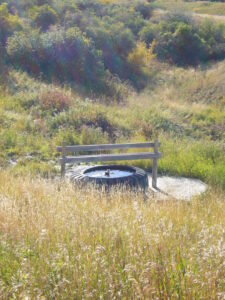 Kelly: We have the great privilege of having natural, free flowing ‘thermal springs’. I say thermal because they don’t freeze, they run all year long. We’ve developed those springs with
Kelly: We have the great privilege of having natural, free flowing ‘thermal springs’. I say thermal because they don’t freeze, they run all year long. We’ve developed those springs with
gravity and pipe. So we use only off-site systems to water cattle, but even at the ranch where we don’t have power and where we don’t have wells, we are extremely lucky to have these free flowing springs, which provide us with ample water even during the winter. Where we
don’t have springs, we pump water using solar from catch basins, or wetlands, so the cattle are fenced out of those sensitive areas.
We have designed a few winter watering systems, as well, that we’ve learned from some of our colleagues, including the Foothills Grazing Association. One of these systems, basically, is a culvert that’s placed vertically into the ground with a pipe at the static level of a catch basin. When we want to pump from one of these, we have a trough that’s designed with little holes in it with an electronic eye at the top of it. So when a cow breaks the beam, it triggers the solar system to charge the system. After 12 seconds of no one breaking the beam, then all the water drains back down through the culvert through the pipe and back into the catch basin, so it doesn’t freeze. We’ve used this technology for quite a few years in grazing spots without winter water troughs.
What are the biggest challenges you’re facing in regards to climate and environment?
Kelly: Probably the biggest challenge has been a five-year drought cycle. We’ve gotten some rain, don’t get me wrong, but what’s happened is that we get rain early, we’re able to seed crops, and then we have had some super hot periods in August. For us to have three to four weeks of 35 degree Celsius weather is definitely different than what we’re used to, and that’s had a great impact on crops, especially spring seeded crops.
We’ve had to find ways to negotiate the heat and drought, and sometimes we’ve had to just cut the crop early and bale it, and then turn around and roll the bales out instead of swath grazing. Or, we have to move our cows more frequently at the ranch because we always want to leave grass behind as that protective ‘sunscreen’ cover for the soil. That’s called drought-proofing.
Glen: Purchasing feed has been very expensive, and we have had to purchase more feed than we typically would have had to in the past. Partly because of reduced yields on cover crops, but also partly because we were intent on not overgrazing. This has been difficult, especially when you know that over the last four years, feed has basically doubled in price. People say you cannot buy your way out of a drought.
Kelly: Another thing that we’ve noticed over the last couple years is that, due to the drought, we tend to have more pests show up. We haven’t been inundated with grasshoppers as some folks have further east of us, but we’ve certainly been impacted by flea beetles. Flea beetles come with canola and there’s a lot of canola around us — and flea beetles really, really like brassicas. So we are actually moving away from the brassica in our cover crop cocktail. We’re going to try seeding sorghum grass in with our oats, peas and sunflowers to hopefully manage the flea beetles.
But you know, we actually feel like we have done okay through the drought because of the drought proofing we have done in the past. We didn’t graze our ground to nothing; we still have a little bit of grass left. The bottom line is that we’ve learned some really, really important lessons from allies over the last 40 years, which has helped us to leave our place in a better spot than we would have without that knowledge.Can you share more about your involvement in the wider community — and your participation in the Living Labs?
Kelly: We are currently involved with two living labs. One of these labs focuses on Alberta beef, and the other on food, water, and wellness. It’s pretty cool to be engaged with both of them right now. We’re looking forward to the work that will be carried out on our land over the next several years, as well as the opportunity to collaborate with scientists and individuals who can teach us and learn from our land. As for the land acquisition, it’s a work in progress, but we’re quite excited about it. We’re actually getting close to finalizing one piece and still working on more. One important message I’d like to share is that it’s a process. This land has been under our rental for 20 to 25 years, and we’ve always treated it as our own. We’ve also implemented many regenerative practices on these pieces of land, making a significant investment in natural capital. That’s why we’re so focused on trying to acquire it.
Regarding the other regenerative partners we work with, we often refer to them as our allies. We collaborate with several NGOs and friends who have taught us a lot about best management practices, riparian habitat, regenerative agriculture, and the importance of bringing together diverse perspectives, opinions, and experts. This is particularly crucial in today’s world and society. We have close working relationships with organizations such as the Alberta Conservation Association, Cows and Fish, and the Old Man Watershed Council. We’re also proud members of the Foothills Forage and Grazing Association. We attend as many workshops as we can and regularly host field tours at our place, bringing our colleagues together in various contexts, whether it’s with Cows and Fish, Foothills Forage, or the Old Man Watershed. We find it exciting to be continuous learners and to provide a space for others to learn.
It’s interesting to note that we are now involved in two living labs, but we’ve always considered our ranch as a living lab as well. We have a diverse group of students, scientists, artists, and fellow ranchers who regularly visit to learn about various aspects. It’s something we’ve always been willing to do, sharing our ranch with many people. This aligns with our shift towards the regenerative paradigm and the living lab paradigm, where we hope to keep learning and help others who represent the future of agriculture, science, or conservation. We want them to have hands-on learning experiences, as we believe that learning from a book is only part of the process. The rest of the learning happens when you get your hands dirty, and that’s always been important to Glen and me.
Any last thoughts you wanted to share about Timber Ridge with the community?
Kelly: We’re just excited to talk to people and tell our story. I think, if anything, we’ve learned a lot from all of our allies being at the ranch, but we’ve also learned that agriculture doesn’t tell its story very well. So we appreciate any opportunity to try to help the rest of society understand what we do out here. We want people to understand that we face our challenges like drought, or market situations or whatever, but also recognize that we produce food, and the healthier our water and soil are, the better our food is. We produce that in a responsible manner and look forward to continuing to do that. We’re always happy that we’ve had the opportunity to have Open Farm Days at our place to bring people out and have them walk through the grasses and the flowers, and fill their water bottles from a free-flowing spring. Those kinds of things are always important steps for us to take, opening the farm for people to come, learn, listen, see, touch, hear, and smell. I think it’s really important because a lot of society has lost a connection to where their food comes from.
—

